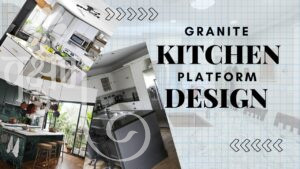Tips for Designing Small Modular Kitchens: Maximizing Space and Efficiency
Tips for Designing Small Modular Kitchens: Maximizing Space and Efficiency
Designing a small modular kitchen requires creativity and strategic planning to ensure that the space is both functional and aesthetically pleasing. With urban living spaces becoming increasingly compact, the need for efficient kitchen solutions has never been greater. This article provides detailed tips on designing small modular kitchens, helping you make the most of every square inch while maintaining a stylish and practical environment.
1. Plan the Layout Carefully
The layout is the backbone of any kitchen design. For small modular kitchens, three common layouts are particularly effective:
- L-Shaped Layout: Ideal for corners, this layout makes excellent use of available space, providing ample countertop and storage areas.
- U-Shaped Layout: This maximizes space by utilizing three walls for storage and appliances, but it requires careful planning to avoid a cramped feeling.
- Galley Layout: Suitable for narrow spaces, this layout places two parallel countertops with a walkway in between, making it easy to move around and work efficiently.
2. Optimize Storage Solutions
Efficient storage is crucial in small kitchens. Here are some tips to maximize storage:
- Use Vertical Space: Install tall cabinets that reach up to the ceiling to utilize vertical space effectively. Consider using the upper shelves for items that are used less frequently.
- Incorporate Pull-Out Shelves and Drawers: Pull-out shelves and drawers make it easier to access items stored in the back, ensuring that no space is wasted.
- Add Corner Units: Lazy Susans or pull-out corner units can make the most of awkward corner spaces.
3. Choose the Right Appliances
In a small kitchen, every appliance needs to be carefully chosen to fit the space and meet your needs:
- Compact Appliances: Opt for smaller versions of essential appliances, such as a slim refrigerator, a compact dishwasher, and a single-bowl sink.
- Built-In Appliances: Built-in ovens, microwaves, and dishwashers save counter space and create a seamless look.
- Multi-Functional Appliances: Consider multi-functional appliances like a microwave-oven combo or a washer-dryer unit to save space.
4. Emphasize Lighting
Good lighting is essential in a small kitchen to make it feel more open and inviting:
- Layered Lighting: Combine ambient, task, and accent lighting to create a well-lit kitchen. Under-cabinet lights are perfect for illuminating workspaces, while pendant lights can add a decorative touch.
- Reflective Surfaces: Use glossy finishes for cabinets and countertops to reflect light and make the space appear larger.
5. Utilize Light Colors
Light colors can make a small space feel bigger and more open:
- Neutral Tones: Whites, creams, and light grays are excellent choices for cabinets, walls, and countertops. These colors reflect light and create a bright, airy atmosphere.
- Contrasting Accents: Introduce contrasting accents with darker colors or bold hues in small doses, such as on a backsplash or accessories, to add interest without overwhelming the space.
6. Incorporate Smart Organization Solutions
Keeping the kitchen organized is key to maintaining its functionality:
- Magnetic Strips and Hooks: Use magnetic strips to store knives and metal utensils. Install hooks under cabinets or inside doors for hanging pots, pans, and other kitchen tools.
- Drawer Dividers: Drawer dividers help keep utensils and small items neatly organized and easily accessible.
- Open Shelving: Open shelves can be used for frequently used items, adding a decorative element while keeping things within reach.
7. Maximize Counter Space
Counter space is precious in a small kitchen, so it’s important to maximize it:
- Foldable or Extendable Countertops: Consider installing a foldable or extendable countertop section that can be used as an additional workspace when needed and tucked away when not in use.
- Integrated Cutting Boards: Built-in cutting boards that slide over the sink can provide extra prep space without taking up additional room.
8. Choose Space-Saving Furniture
Furniture in a small kitchen should be functional and space-saving:
- Nesting Tables and Stools: Nesting tables and stools can be tucked away when not in use, freeing up valuable floor space.
- Slim Profile Furniture: Opt for slim profile tables and chairs that do not overwhelm the space but still provide adequate seating and dining options.
9. Consider Sliding Doors
Sliding doors take up less space than traditional hinged doors and can be used for:
- Cabinet Doors: Sliding cabinet doors save space and can be easier to open in tight areas.
- Room Dividers: Use sliding doors to separate the kitchen from other areas without taking up extra space.
10. Personalize with Decorative Elements
Even in a small kitchen, there’s room for personal touches that make the space your own:
- Backsplash Designs: Choose a stylish backsplash design to add personality and visual interest. Glass tiles, mosaic patterns, or bold colors can make a statement.
- Greenery: Small potted plants or a vertical herb garden can add a touch of nature and freshness to the kitchen.
- Art and Accessories: Incorporate small pieces of art or unique accessories that reflect your style without cluttering the space.
Conclusion
Designing a small modular kitchen requires careful planning and creativity, but with the right strategies, you can create a space that is both functional and beautiful. By optimizing storage, choosing the right appliances, and incorporating smart design elements, you can make the most of every inch and enjoy a kitchen that meets all your needs. Whether you’re renovating an existing kitchen or starting from scratch, these tips will help you create a small modular kitchen that is efficient, stylish, and a joy to use.





